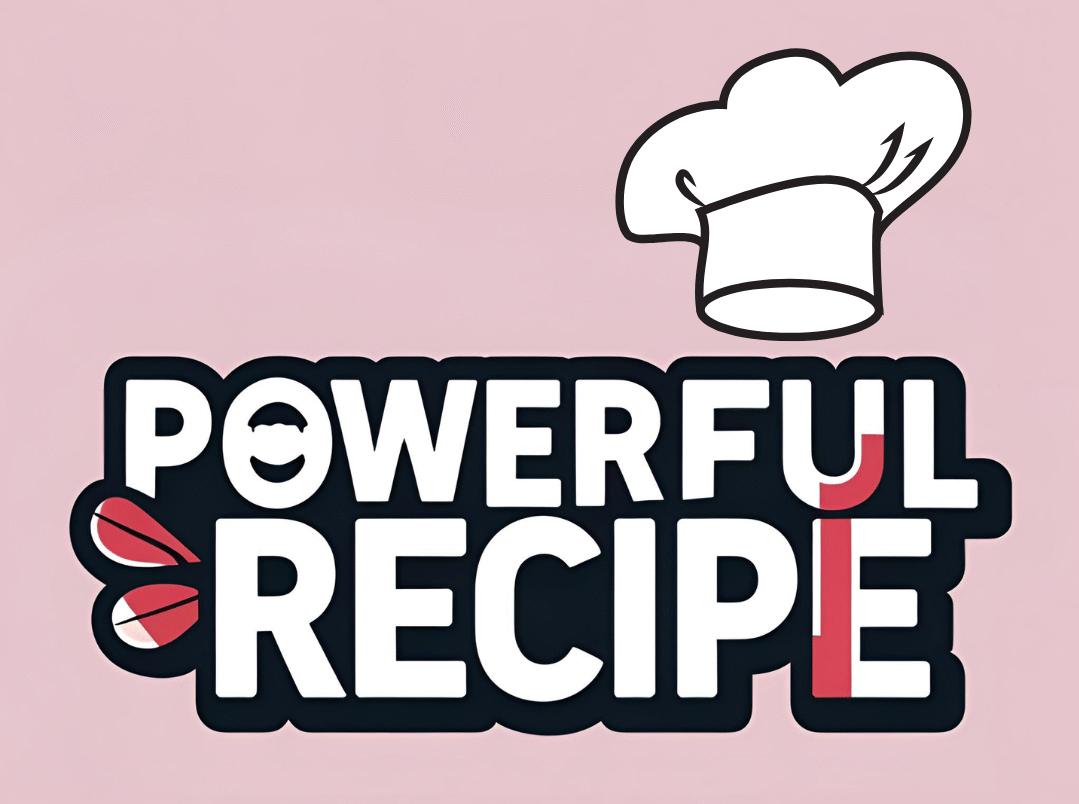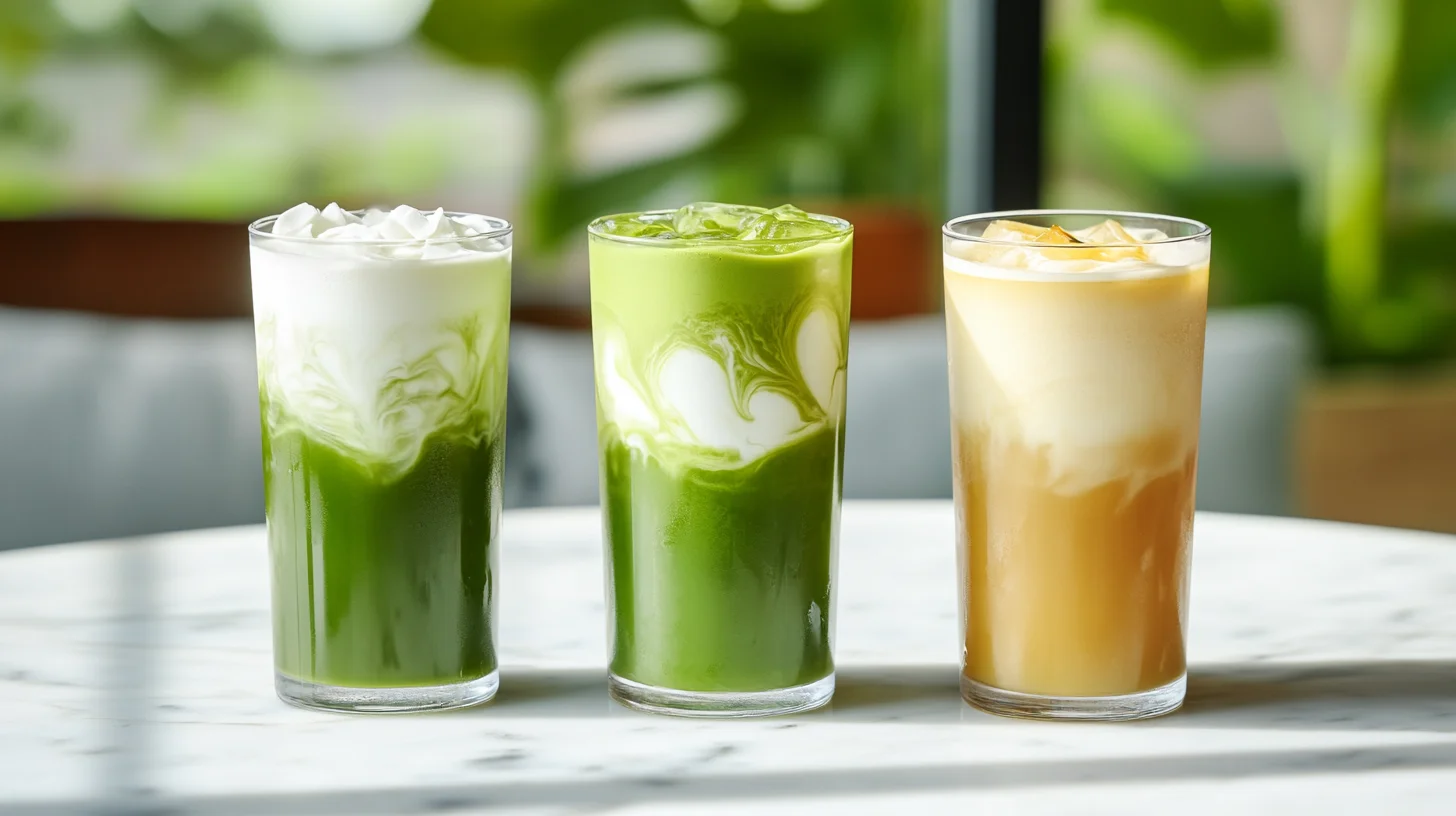Iced matcha latte recipe has become a beloved beverage across the globe, celebrated not just for its bright green hue but also for its unique flavor and impressive health benefits. Whether you’re sipping one from your favorite coffee shop or crafting it at home, this cool and creamy drink offers the perfect blend of energy, calm, and refreshment. But what if you could make a barista-style iced matcha latte right in your own kitchen—with no fancy tools, and in just minutes?
This guide reveals 17 insider secrets to mastering the iced matcha latte recipe, from choosing the right matcha powder to customizing flavors like vanilla, coconut, or even floral infusions. You’ll also learn how to avoid common mistakes, how to make your latte healthier, and how to tweak it to suit every season. Whether you’re a beginner or a matcha enthusiast, this comprehensive recipe and guide is designed to help you perfect your technique and make each sip better than the last.
So, grab your whisk or blender—we’re about to dive into a delicious and energizing world where matcha meets ice-cold milk and sweet, subtle flavors.
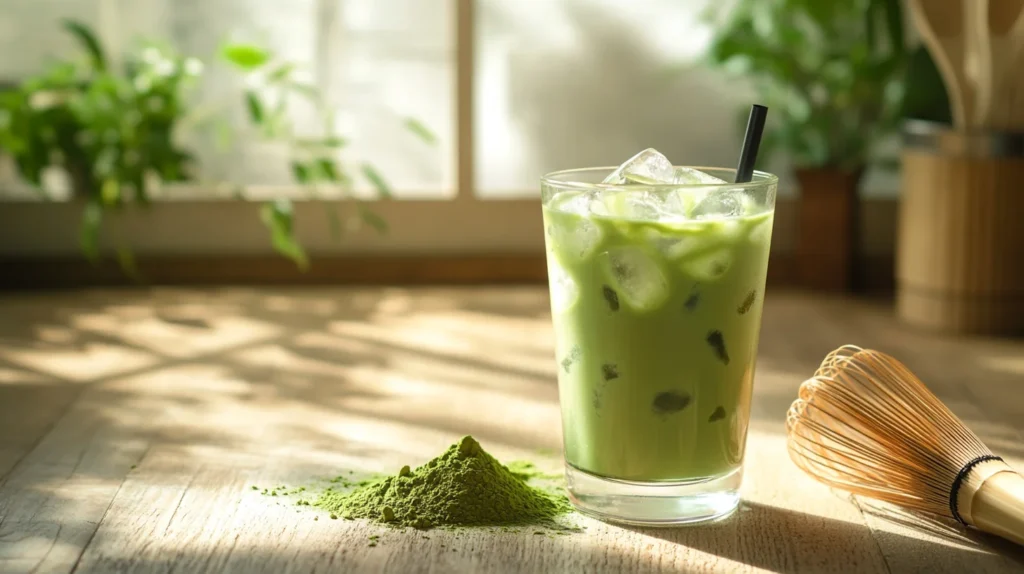
What Is an iced matcha latte recipe?
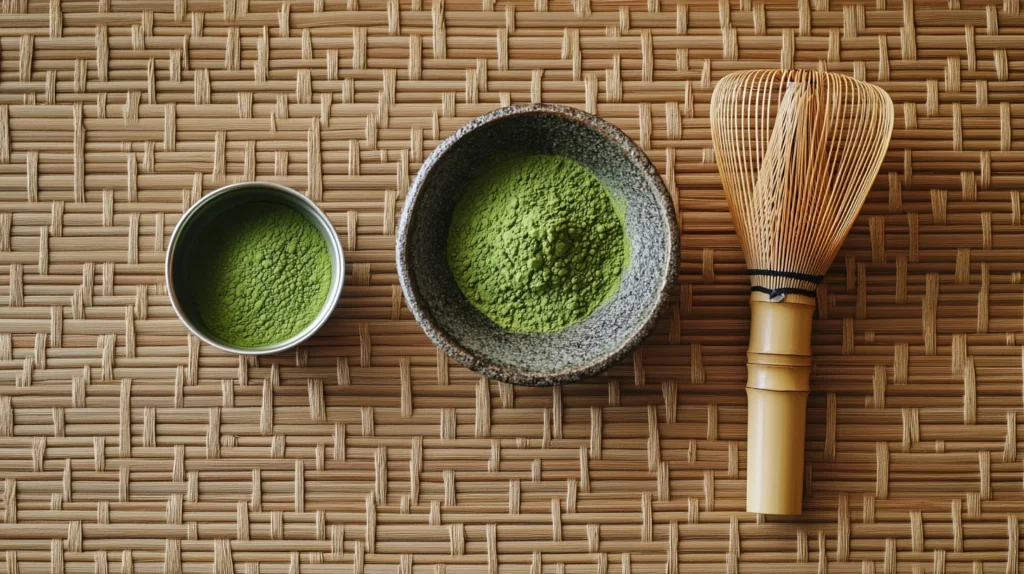
Matcha lattes—hot or iced—have surged in popularity thanks to their vibrant color, unique flavor, and healthy ingredients. But before you dive into the recipe, it’s important to understand what sets the iced matcha latte recipe apart from other tea-based beverages.
Origins of Matcha
Matcha is a finely ground powder made from specially grown and processed green tea leaves. It originated in China during the Tang Dynasty, but it was Japan that truly refined the cultivation and ceremonial use of matcha. The process of growing matcha involves shading the tea plants for weeks before harvest to boost their chlorophyll content. This gives matcha its brilliant green color and concentrated nutrients.
Unlike traditional green tea where leaves are steeped and removed, matcha involves consuming the entire leaf in powdered form. This means you’re getting significantly more antioxidants and nutrients with every sip.
What Makes iced matcha latte recipe Unique?
An iced matcha latte recipe is essentially a cold version of the traditional matcha latte. It combines matcha powder with water, milk (dairy or plant-based), a sweetener if desired, and ice. The result is a smooth, frothy, and refreshing drink with a rich umami taste balanced by a creamy texture.
What makes it stand out from iced teas or other coffee-shop drinks is its mix of bitter, sweet, and savory notes. When prepared well, the layers of flavor unfold subtly with every sip, providing a multi-dimensional taste experience. Iced matcha lattes are also highly customizable, allowing you to play with milks, flavorings, and sweetness levels.
Health Benefits of Matcha
One of the reasons matcha has taken the health world by storm is because of its impressive nutritional profile. Far beyond being a trendy drink, matcha provides a multitude of health benefits that make the iced matcha latte more than just a tasty refreshment.
Antioxidants and EGCG
Matcha is famously rich in antioxidants—particularly catechins. The most powerful of these is EGCG (epigallocatechin gallate), which has been shown to have strong anti-inflammatory and cancer-fighting properties. Since you consume the entire tea leaf in powder form, matcha delivers up to 137 times more antioxidants than regular green tea.
Antioxidants help your body combat oxidative stress, reduce cellular damage, and support immune health. Drinking an iced matcha latte regularly may help reduce the risk of chronic illnesses and improve overall wellness.
Energy Without the Jitters
While matcha contains caffeine, it provides a different kind of energy boost compared to coffee. That’s because it also contains L-theanine, an amino acid that promotes calm and enhances focus. The combination of L-theanine
with caffeine results in what many call “alert calmness”—an energized state without the crash or jitters typically associated with coffee.
This makes iced matcha lattes an excellent choice for students, professionals, or anyone looking to stay mentally sharp and physically relaxed.
Good for Skin and Detox
The chlorophyll-rich nature of matcha contributes to its detoxifying properties. Chlorophyll helps cleanse the blood, support liver health, and eliminate harmful toxins from the body. Many skincare enthusiasts also report improvements in skin clarity and brightness after incorporating matcha into their diets.
The antioxidants in matcha also protect against UV damage and may slow down the skin’s aging process by reducing free radicals. An iced matcha latte isn’t just good for your taste buds—it’s good for your glow!
Essential Ingredients for the Perfect Iced matcha latte recipe
Crafting a great iced matcha latte recipe starts with selecting high-quality ingredients. The right matcha powder, milk, and sweeteners can make all the difference between a bland, gritty drink and a creamy, smooth delight.
Choosing High-Quality Matcha Powder
Matcha quality varies widely, and the best option for lattes is typically ceremonial grade matcha. This grade offers a vibrant green color, smooth taste, and fine texture. It’s slightly more expensive than culinary grade, but the flavor and benefits are worth it.
Here’s what to look for when choosing your matcha:
- Color: Bright, vibrant green indicates freshness and high chlorophyll content.
- Smell: Fresh matcha should smell grassy and slightly sweet.
- Origin: Matcha from Uji (Japan) or Nishio is considered top-tier.
- Texture: It should feel silky, not gritty.
Culinary-grade matcha is more affordable and suitable for baking or smoothies, but for lattes, ceremonial grade provides the best experience.
Milk Options: Dairy vs. Non-Dairy
The type of milk you use can significantly influence the flavor and texture of your iced matcha latte. While traditional recipes use cow’s milk, many people prefer plant-based alternatives for dietary, health, or flavor preferences.
Popular milk options include:
- Whole milk: Rich and creamy, it enhances the umami flavor of matcha.
- Oat milk: A favorite for its natural sweetness and smooth texture.
- Almond milk: Light and nutty, ideal for a more delicate drink.
- Coconut milk: Adds a tropical twist but can overpower if used too much.
- Soy milk: Neutral and protein-rich, a classic dairy alternative.
Each milk alters the final flavor slightly, so don’t be afraid to experiment.
Sweeteners and Flavor Enhancers
Matcha has a naturally earthy, slightly bitter taste, so sweeteners can help balance the flavor, especially for newcomers. Choose a sweetener that dissolves well in cold liquids and doesn’t overpower the matcha.
Recommended sweeteners:
- Honey (dissolved in warm water first)
- Maple syrup
- Agave nectar
- Simple syrup
- Stevia or monk fruit (for low-carb versions)
Flavor enhancers such as vanilla extract, cinnamon, or a drop of lavender syrup can take your iced matcha latte to the next level.
Equipment You’ll Need
Making an iced matcha latte recipe doesn’t require a fully stocked tea ceremony set—though using traditional tools can add to the experience. Whether you go old-school or modern, having the right equipment ensures a smooth, frothy, and delicious final product.
Traditional Tools (Chasen, Chawan)
If you’re going for authenticity, consider using:
- Chasen (bamboo whisk): Designed specifically for matcha, this tool helps dissolve the powder and create a frothy top layer.
- Chawan (matcha bowl): A wide, shallow bowl ideal for whisking matcha evenly.
- Chashaku (bamboo scoop): Helps you measure matcha precisely, usually 1 to 2 scoops per serving.
These tools are used in Japanese tea ceremonies and elevate the ritual aspect of making matcha.
Modern Kitchen Alternatives
Not everyone has a chasen on hand, and that’s perfectly fine. Here are easy substitutes:
- Milk frother: An electric frother creates creamy foam and mixes the matcha well.
- Blender: Great for dissolving matcha and blending all ingredients evenly.
- Mason jar with lid: Shake up your ingredients for a foamy result.
- Fine mesh strainer: To sift the matcha powder before mixing and avoid lumps.
No matter what method you use, the key is to mix thoroughly to avoid a gritty texture.
Step-by-Step Iced Matcha Latte Recipe
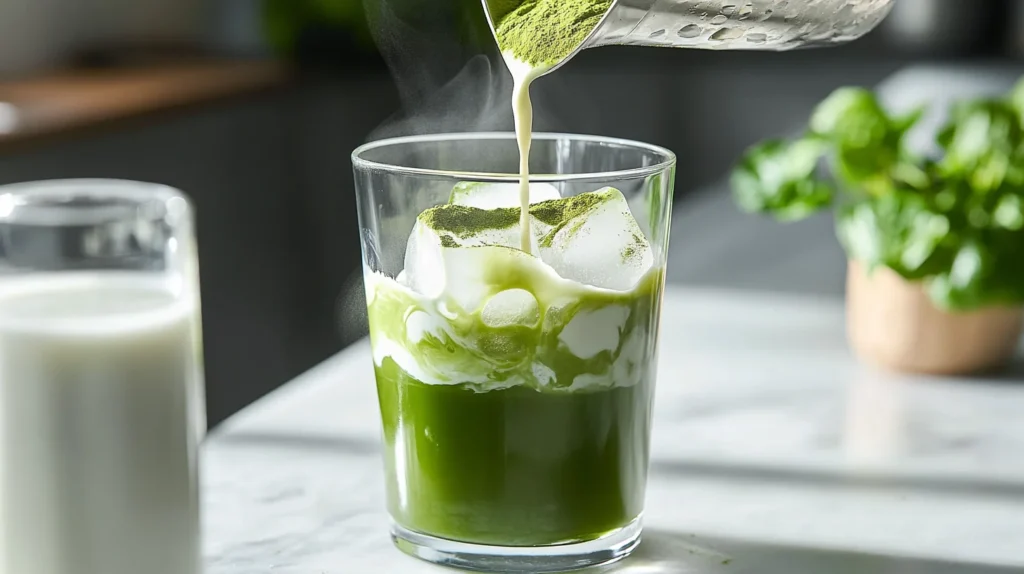
Here’s the ultimate iced matcha latte recipe broken down into easy, repeatable steps. With these directions, you’ll be able to whip up a creamy, vibrant latte that rivals your favorite café.
Step 1: Sift the Matcha
Use a small mesh strainer or sifter to remove clumps from the matcha powder. Sifting helps it dissolve more easily in water and prevents a gritty texture.
Pro Tip: Sift directly into your mixing bowl or cup to avoid losing powder.
Step 2: Whisk with Hot Water
Add about 1–2 teaspoons of sifted matcha powder into a bowl or cup. Pour in 2 ounces of hot (not boiling) water—ideally around 160–175°F (70–80°C).
Now whisk!
- If using a chasen: Whisk briskly in an “M” or “W” motion until frothy.
- If using a frother: Blend for 15–20 seconds until a smooth foam appears.
- If using a jar: Add a lid and shake vigorously for 30 seconds.
This step is essential to “activate” the matcha and create a smooth base.
Step 3: Add Ice and Milk
Fill a tall glass with ice cubes—enough to chill but not overflow. Pour your frothed matcha over the ice, then add 3/4 cup of your preferred milk (dairy or non-dairy). Stir gently to combine.
For a layered look, pour the milk first, add the ice, then slowly pour the matcha over top.
Step 4: Customize to Taste
Now it’s time to personalize your latte:
- Add 1–2 teaspoons of sweetener (maple syrup, simple syrup, etc.).
- A few drops of vanilla extract can enhance the flavor.
- For a protein boost, mix in a splash of collagen or protein milk.
Taste and adjust based on your preferences. Some people like it sweeter, others prefer a strong matcha flavor. There’s no wrong way to make it—just your way.
Common Mistakes to Avoid
Even though the iced matcha latte recipe is simple, small errors can affect taste, texture, or appearance. Here are the most common pitfalls and how to avoid them so your matcha turns out perfect every time.
Using Low-Quality Matcha
Not all matcha is created equal. If your iced latte tastes overly bitter, chalky, or dull in color, you’re likely using low-grade or stale matcha. Always opt for fresh, vibrant green ceremonial grade for lattes. Store it in an airtight container away from heat and light to preserve its flavor and nutrients.
Overheating the Water
Water that’s too hot can scorch the matcha powder, leading to a bitter, burnt flavor. Matcha is delicate and needs water heated to around 160–175°F (70–80°C). If you don’t have a thermometer, boil water and let it sit for a minute before pouring.
Overheating also breaks down the healthy catechins in matcha, reducing its nutritional benefits—so keep it cool, not boiling.
Not Mixing Properly
Clumpy matcha? Gritty texture? These are signs that your powder wasn’t sifted or whisked properly. Always sift your matcha to remove lumps, and whisk it thoroughly with hot water to dissolve completely before adding ice or milk.
If you’re using a milk frother, give it enough time to fully blend. A few extra seconds can make the difference between a smooth latte and a disappointing one.
Flavor Variations to Try
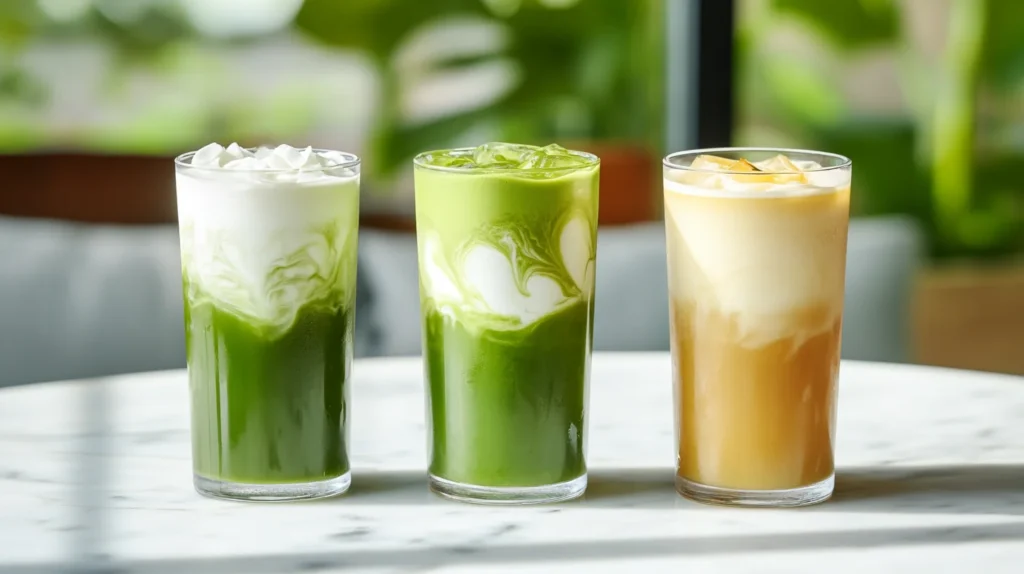
Once you’ve mastered the basic iced matcha latte recipe, there’s a whole world of flavors to explore. These fun and tasty variations keep things exciting while allowing you to experiment with new textures and pairings.
Vanilla Matcha Latte
A fan favorite, vanilla brings a mellow sweetness that complements the earthiness of matcha beautifully. Add 1/4 teaspoon of pure vanilla extract or a shot of vanilla syrup before adding your milk.
Pro tip: Pair with oat milk for a creamier finish.
Coconut or Almond Twist
For a tropical vibe, try using coconut milk or adding a splash of almond extract. These nutty flavors add richness and variety while still letting the matcha shine.
Optional add-ins:
- Toasted coconut flakes on top
- A drop of almond syrup for extra aroma
Matcha Lemonade Fusion for iced matcha latte recipe
Looking for something ultra-refreshing? Combine matcha with lemon juice and sweetener instead of milk. This creates a tangy, energizing matcha lemonade that’s perfect for hot days.
To make:
- Whisk 1 tsp matcha with 1/4 cup hot water
- Add 1 cup cold water, 2 tbsp lemon juice, and 1–2 tsp sweetener
- Pour over ice and stir
This variation is lower in calories and sugar than a milk-based latte, making it a great lighter alternative.
Iced Matcha Latte for Every Season
Yes, iced matcha latte recipe is a summer staple—but with the right twists, it can be enjoyed all year long. Here’s how to seasonally adapt your iced matcha latte for any time of year.
Summer Cool-Down iced matcha latte recipe
The classic: chilled oat milk, a touch of maple syrup, and a mountain of ice. Add a sprig of fresh mint or cucumber slices for a spa-like twist.
You can even freeze matcha into ice cubes and blend them with milk for a matcha slushie effect.
Autumn Spice Version for iced matcha latte recipe
For a cozy fall drink, add a pinch of cinnamon, nutmeg, or pumpkin spice. Combine with unsweetened almond milk and maple syrup for a matcha spin on the pumpkin spice latte.
Bonus: Warm the milk slightly before pouring it over ice for a comforting contrast.
Spring Floral Infusion for iced matcha latte recipe
Spring is all about freshness and florals. Infuse your iced matcha latte recipe with lavender syrup, rose water, or jasmine extract. These delicate floral notes pair surprisingly well with matcha’s grassy undertone.
Use light-colored milks like rice or almond for a soft visual effect, and garnish with edible flowers if you’re feeling fancy.
Nutritional Information FOR Iced matcha latte recipe
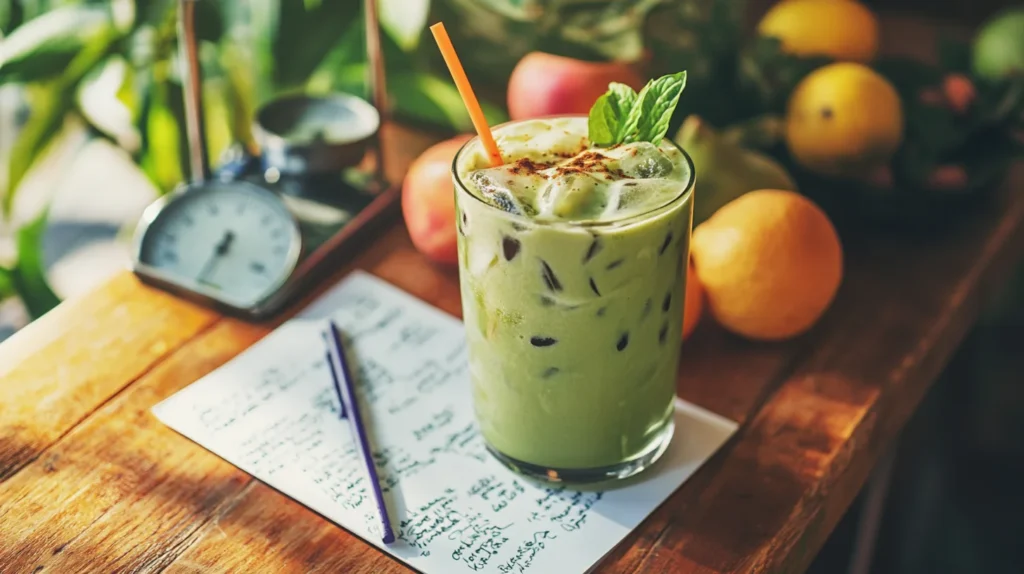
An iced matcha latte recipe isn’t just delicious—it can also be a healthy choice, especially when made with clean, high-quality ingredients. Let’s break down the nutritional value of this vibrant green beverage.
Calories and Macros for iced matcha latte recipe
The calorie count of an iced matcha latte recipe can vary depending on your choice of milk and sweetener. Here’s a basic nutritional snapshot for a standard 12 oz iced matcha latte recipe made with oat milk and a teaspoon of maple syrup:
| Nutrient | Amount |
|---|---|
| Calories | 90–140 kcal |
| Protein | 1–3 g |
| Carbohydrates | 10–20 g |
| Sugars | 5–12 g |
| Fat | 2–5 g |
| Caffeine | 30–70 mg |
Matcha’s caffeine content is gentler than coffee but still provides a noticeable energy boost. It’s also packed with amino acids, particularly L-theanine, which promotes calm and focus.
Sugar Content Tips for iced matcha latte recipe
To keep your drink low in sugar:
- Skip sweeteners altogether if you enjoy a strong, earthy taste.
- Use stevia or monk fruit extract for a zero-calorie option.
- Add just a splash of vanilla almond milk, which is often pre-sweetened.
Remember, even natural sweeteners like honey or agave can add up, so use them in moderation.
How to Make it Healthier for iced matcha latte recipe
If you want a more nutritious iced matcha latte recipe, consider these healthy tweaks:
- Use unsweetened almond or soy milk to reduce calories.
- Add chia seeds or flaxseeds for fiber and omega-3s.
- Stir in collagen powder for skin and joint support.
- Use homemade simple syrup with honey or coconut sugar.
The matcha itself already brings antioxidants, chlorophyll, and gentle caffeine. With a few smart choices, your latte becomes both a treat and a wellness boost.
Pairing Suggestions FOR Iced matcha latte recipe
A great iced matcha latte recipe deserves an equally great snack or meal to go with it. Whether you’re enjoying it in the morning or as an afternoon pick-me-up, the right pairing enhances the experience.
Best Foods to Enjoy with Matcha
Matcha’s earthy notes pair well with a wide variety of foods, especially those that contrast with or balance its flavor profile. Some top pairings include:
- Light tea sandwiches (cucumber, egg salad)
- Rice cakes or mochi
- Fruit bowls with berries or mango
- Nut-based granola bars
Matcha’s umami flavor also plays nicely with creamy or slightly salty foods.
Light Snacks vs. Sweet Treats
Looking for something more indulgent? Iced matcha latte recipe are also fantastic with sweets. Try:
- Almond biscotti
- Vanilla macarons
- White chocolate chip cookies
- Shortbread or scones
The key is balance—too much sugar can overpower the subtle complexity of matcha. If your latte is sweetened, opt for simpler snacks. If it’s plain or earthy, go ahead and indulge in a richer dessert.
Whether you’re pairing your iced matcha latte with a light meal like these vibrant Greek Chicken Bowls, indulging in a sweet treat such as the Pistachio Kunafa Brownies, or keeping it fresh and seasonal with the Pear Salad Recipe, there’s no shortage of delicious pairings to elevate your matcha moment.
Frequently Asked Questions
How to make iced matcha latte?
To make a refreshing iced matcha latte recipe, follow these simple steps:
Sift 1 to 2 teaspoons of ceremonial grade matcha powder into a bowl to eliminate clumps.
Add about 2 ounces of hot water (160–175°F) and whisk vigorously in an “M” or “W” motion until smooth and frothy.
Fill a tall glass with ice cubes, then pour your frothed matcha over the ice.
Add 3/4 cup of milk of your choice (oat, almond, dairy, soy, etc.).
Sweeten to taste using maple syrup, honey, or simple syrup.
Stir gently and enjoy!
This recipe yields a creamy, cool, and energizing drink perfect for any time of day.
Are iced matcha lattes healthy?
Yes—iced matcha latte recipe can be very healthy, especially when made at home with clean ingredients. Matcha is loaded with antioxidants, particularly EGCG, which helps reduce inflammation and fight free radicals. It also provides calm energy due to its unique combination of caffeine and L-theanine.
To keep it healthy:
Use unsweetened plant-based milk
Avoid adding too much sugar
Choose ceremonial grade matcha for the highest benefits
Homemade versions are generally healthier than store-bought ones, which may contain sweetened matcha blends or artificial flavors.
What does Starbucks put in iced matcha latte?
Starbucks uses a pre-sweetened matcha blend for their iced matcha latte recipe, which includes:
Matcha green tea powder
Sugar (already mixed in)
Milk (dairy or non-dairy, depending on your choice)
Because the powder is pre-sweetened, the drink already contains added sugar, even before any extra syrup or customization. You can ask for fewer scoops of matcha to reduce sweetness, or switch to plant-based milks like oat or almond for a lighter version.
What’s the difference between iced matcha and iced matcha latte?
The key difference lies in the milk content:
Iced matcha latte recipe: Matcha powder is mixed with cold water, ice, and sometimes lemon juice or sweetener. It’s more like an iced tea and lighter in body.
Iced matcha latte recipe: Combines matcha with milk and ice, making it creamy, rich, and more filling. It often includes a sweetener as well.
If you want a low-calorie, hydrating drink, go for iced matcha. If you prefer something creamier and satisfying, the iced matcha latte is your best bet.
What brand matcha does Starbucks use?
Starbucks doesn’t publicly reveal the exact brand, but it’s widely believed that they source their matcha powder from Japan, and it’s not ceremonial grade. Instead, it’s a pre-sweetened culinary-grade matcha blend, designed for consistency in flavor, color, and ease of preparation in a fast-paced café setting.
If you’re aiming to replicate Starbucks-style matcha at home, look for sweetened matcha blends—but be aware they often contain added sugar and less antioxidant potency than pure ceremonial grade.
Does Dunkin’ Donuts matcha have sugar?
Yes, Dunkin’s matcha drinks are made with a sweetened matcha powder, which already contains added sugar. According to Dunkin’, their matcha is a blend of ground green tea and sugar, sourced from the Nishio region of Japan.
While the flavor is pleasant and mild, it’s not the best option if you’re watching your sugar intake or want the pure health benefits of matcha. For a cleaner version, try making it at home with unsweetened ceremonial grade matcha and a natural sweetener like stevia or maple syrup.
Conclusion
Whether you’re new to matcha or a long-time fan, mastering the iced matcha latte recipe opens up a world of delicious, health-boosting possibilities right from your own kitchen. This vibrant green drink is more than just an Instagram trend—it’s a smart, energizing, and incredibly customizable beverage that fits every lifestyle and season.
By understanding the basics—like choosing high-quality ceremonial grade matcha, using the right tools and techniques, and selecting your ideal milk and sweetener—you can create a matcha latte that’s just as satisfying as anything you’d find at Starbucks or your favorite café. Better yet, you’ll be saving money and cutting out unnecessary sugars or additives.
From classic to creative, vanilla to coconut, and spring florals to fall spice infusions, there’s no end to the variations you can explore. As long as you respect the balance of matcha’s natural flavors, you’re free to experiment and adapt it to your personal tastes.
So the next time you need a refreshing, nutrient-packed pick-me-up, skip the drive-thru and grab your matcha whisk—or blender—and make your own iced matcha latte at home. It’s easier than you think, and with every sip, you’ll enjoy a drink that’s as good for your body as it is for your soul.

Iced Matcha Latte Recipe
Equipment
- Fine mesh sieve or tea strainer
- Matcha bowl (chawan) or regular mixing bowl
- Bamboo whisk (chasen), milk frother, or electric whisk
- Measuring spoons
- Tall glass
- Spoon or stir stick
Ingredients
- 1 to 2 teaspoons ceremonial grade matcha powder
- 2 oz hot water 160°F to 175°F / 70°C to 80°C
- 3/4 cup cold milk oat, almond, cow’s, soy, etc.
- 1 –2 teaspoons maple syrup or sweetener of choice optional
- 1 cup ice cubes
Instructions
- Sift the Matcha: Use a fine mesh sieve to sift the matcha powder into a bowl. This prevents clumps.
- Whisk with Hot Water: Pour 2 oz of hot water over the sifted matcha. Use a bamboo whisk or frother to whisk in a zig-zag motion until frothy.
- Fill the Glass: Add ice cubes to a tall glass.
- Pour and Add Milk: Pour the frothed matcha over the ice. Add your choice of cold milk.
- Sweeten & Stir: Add maple syrup or other sweetener if desired. Stir gently and enjoy immediately.
